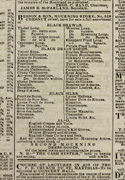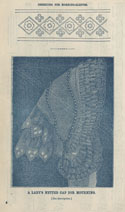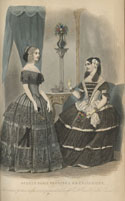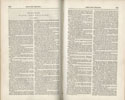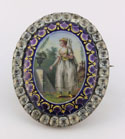Dressed for Mourning
Advertisement for mourning clothing sold by Besson & Son, Philadelphia, in The North American, October 21, 1862, p. 2.
“A Lady’s Netted Cap for Mourning,” in Godey’s Lady’s Book (January, 1858).
Those who could afford it often followed very specific mourning customs after the death of a family member. Women in particular acquired specific black clothing for periods of full mourning and then wore grey and lavender for “half mourning,” before returning to their regular clothes. Godey’s published this image of a woman’s mourning cap, together with the directions for making it stitch by stitch.
“Godey’s Paris Fashions Americanized,” in Godey’s Lady’s Book (September, 1848).
In “half mourning,” a widow might appear quite fashionable, despite the subdued color of her dress. Both women in this plate wear dresses with lace flounces. The woman on the left wears white gloves stitched in black, and the woman on the right carries a handkerchief with a black border, according to the description. One senses that a woman in half mourning might be announcing her half availability to potential suitors!
T. S. Arthur, “Going into Mourning,” in Godey’s Lady’s Book (October, 1841).
In this short story, the prolific writer T. S. Arthur offers a critical view of mourning practices. Following the death of their young son, the Condy family spends a large amount of money for a seamstress to work day and night to outfit them in mourning clothing, despite the fact that the woman is thus forced to leave her sick sister alone. After the sister dies, the seamstress refuses to dress in mourning, saying that it “wouldn’t do any good” – clearly the moral high ground. As a neighbor remarks, “If all the money that was spent in buying mourning was given to the poor, there would be less misery in the world by a great deal.” Then as now, women received conflicting advice from their magazines! It should also be noted that men’s mourning attire was a black armband.
Mourning jewelry. The Museum of Mourning Art at Arlington Cemetery, Drexel Hill, Pennsylvania.
Special jewelry as well as clothing often signaled to others that the wearer was in mourning. Some pieces even contained locks of hair – thus preserving a memento from the body of the deceased. Emblematically, the deceased continued to be present in the lives of the bereaved through such jewelry.
